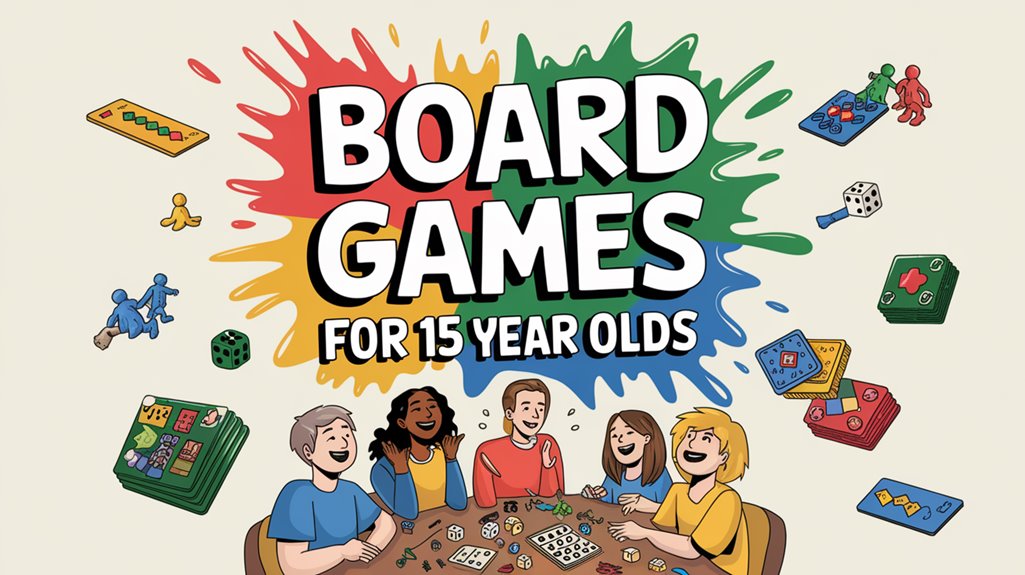Agricultural-themed board games have surged in popularity, offering diverse gameplay experiences centered around farming and resource management. This article will explore notable titles like Agricola, Viticulture, Applejack, and Fields of Green, highlighting their unique mechanics and approaches to farming.
Harvest (2024)

Released in 2024, Harvest is a board game set in Furroughfield, a community of anthropomorphic animals where players take on the role of farmers. The game accommodates 1-4 players, with sessions lasting 30-60 minutes, and is designed for ages 10 and up.
The gameplay structure begins with each player selecting a unique farmhouse that grants distinct advantages throughout the game. The core loop involves two main phases: the Sunrise phase, where players draft cards determining both income and turn order, and the Action phase, where players utilize wheelbarrows to gather resources across the town map.
Players execute agricultural operations through specific action spaces: planting seeds requires placement in designated field spaces, crop maintenance involves worker placement for watering and fertilizing, while harvesting activates when crops reach maturity. Each harvested crop generates both immediate income and victory points, tracked on the game board’s scoring track.
Farm expansion mechanics allow players to clear additional land tiles and construct various buildings. These structures serve dual purposes – providing immediate efficiency bonuses during gameplay while also contributing to end-game scoring conditions. The game concludes after a predetermined number of seasons, with victory awarded to the farmer who accumulates the highest point total through crop sales, building bonuses, and completed objectives.
Applejack (2022)
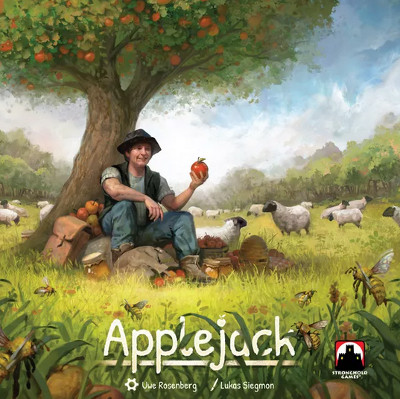
Uwe Rosenberg’s Applejack (2022) is a tile placement game for 1-4 players that takes 30-60 minutes to play.
Players compete over 19 turns, selecting tree tiles from a central harvest board containing specific combinations of apples, blossoms, and beehives. The game’s core mechanism revolves around connecting beehive networks – each new beehive tile must link to existing hives to generate honey tokens. The Applejack die serves as the game’s harvest trigger; when rolled, it activates apple collection from trees matching the die’s icons.
Tile placement follows strict adjacency rules: beehives must form continuous paths, while apple trees need strategic positioning to optimize harvest opportunities when the die triggers collection. Each turn presents players with three available tree tiles to choose from, adding depth to the decision-making process.
The scoring system evaluates three distinct categories:
- Harvested apples
- Completed blossom patterns
- Accumulated honey tokens
The game, designed for ages 8 and up, concludes when players have completed their 19 turns, with the highest total score determining the winner.
La Granja
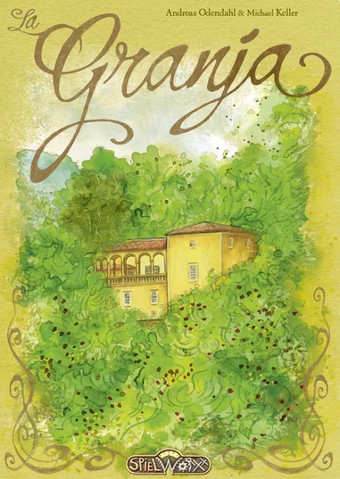
La Granja transports players to medieval Mallorca, where they compete to develop farms near the village of Esporles.
Players manage their estates across six distinct rounds, utilizing a blend of card-drafting and dice-placement mechanics. The game supports 1-4 players with a playtime of 90-120 minutes. Each round, participants draw cards representing fields, farm extensions, and helpers while responding to dice results that determine available actions. The multi-use cards can be played in four different ways: as fields for crop cultivation, as extensions that provide special abilities, as helpers offering unique actions, or as market deliveries.
Resource production follows a specific sequence: players harvest crops from fields, collect goods from farm extensions, and fulfill market contracts in the village. The innovative “siesta” track determines player order and provides bonus actions. Farm extensions can be built using specific resource combinations, while market deliveries require exact matches of goods to score victory points. Special scoring opportunities arise through helper cards and completed delivery routes. The game ends after six rounds, with the highest point total claiming the La Granja estate title.
Life on the Farm Board Game (1996)
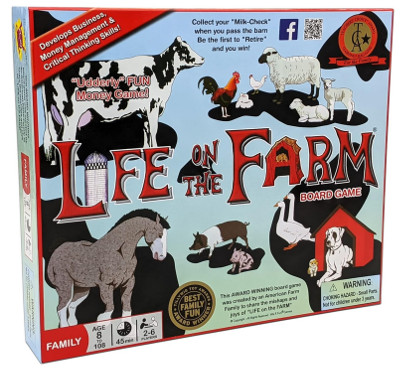
Life on the Farm, released in 1996 by an American farming family, puts 2-6 players in charge of their own dairy operations.
Players roll dice to move around the board, making calculated decisions about purchasing and selling cows while managing their milk production income and farm expenses. The game length averages two hours, during which participants aged 8 and up engage in agricultural commerce. Key gameplay elements include:
- Dairy herd management through strategic buying and selling
- Income tracking from milk production
- Expense management including feed costs and veterinary bills
- Goal of reaching retirement through specific cow numbers and capital requirements
The game’s educational merits earned three stars from an education review board for teaching financial literacy and decision-making skills. While the roll-and-move mechanics remain straightforward, each turn presents players with concrete choices about herd optimization and profit maximization as they traverse the farm-themed board spaces. The victory condition requires careful balance of resources and timing to achieve the retirement threshold through successful dairy operations.
Agricola (Revised Edition) (2016)
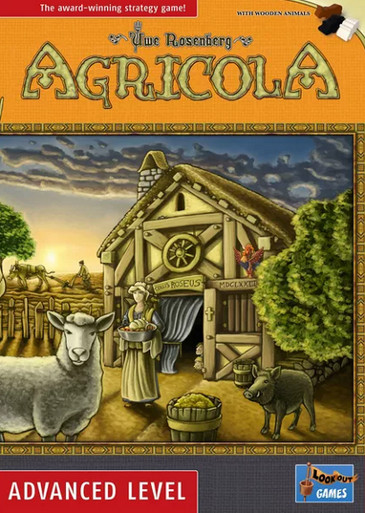
The 2016 revised edition of Agricola streamlines Uwe Rosenberg’s farming simulation while maintaining its strategic depth. This 1-4 player game features enhanced wooden components and a refined card selection from the base game and expansions.
Players operate a 17th-century farm, starting with two family members who must be fed each harvest. The action-selection mechanism provides 14 rounds, with new action spaces revealed each stage. On their turn, players place workers to perform one action: collecting resources (wood, clay, reed, stone), building fences, acquiring animals (sheep, wild boar, cattle), plowing fields, or sowing grain and vegetables. Room expansions require specific building materials and allow for family growth, providing additional worker actions per round.
The game’s scoring system evaluates farm diversity: field cultivation, pasture development, animal husbandry, and house improvements all contribute to final points. Negative points are assessed for unused farm spaces and missing farm elements. A comprehensive occupation and improvement card system (48 cards each) offers distinct strategic paths each game.
Technical specifications:
- Playing time: 30 minutes per player
- Age recommendation: 12+
- Component count: 360 cards total
- Board dimensions: 25.5 x 25.5 inches when fully assembled
- Includes 5 individual player boards
Fields of Green (2016)
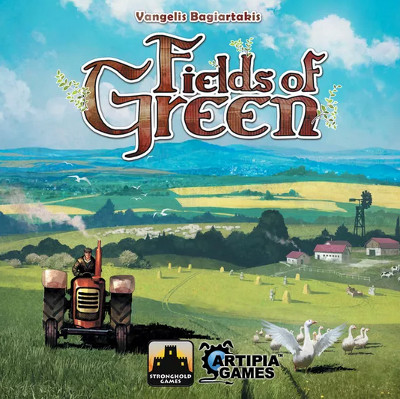
Fields of Green (2016) is a card-drafting agricultural game designed for 2-4 players with a playtime of 60-90 minutes.
Players take on the role of 1950s farm owners competing over four rounds (years) to build the most profitable agricultural enterprise. Each round consists of seven turns where players draft and place location cards from a shared pool into their tableau. The game features four distinct card types: fields for crop cultivation, livestock areas, buildings for storage and processing, and water facilities to irrigate crops.
During each round, players must carefully position their cards to create efficient production chains while managing three key resources: water tokens, money, and food storage. Water towers must be strategically placed to supply adjacent fields, while silos and markets help store and sell harvested goods. The harvest phase occurs after each round, requiring players to pay maintenance costs and gather income from their established facilities.
The game’s scoring system rewards diversification and synergies between different farm elements. Victory points are earned through various means: completed production chains, fulfilled market demands, livestock outputs, and building bonuses. After four rounds, players calculate their final scores, including end-game bonuses from specific card combinations and achieved objectives.
The modular nature of card drafting, combined with varied starting conditions and multiple scoring opportunities, ensures high replayability despite the fixed four-round structure.
Farm-opoly (2005)
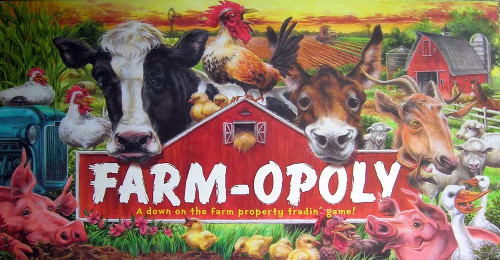
Farm-opoly (2005) is an agricultural spin on Monopoly for 2-6 players aged 8 and up, with a 60-minute estimated playtime.
The game offers two distinct modes: The traditional endless format continues until bankruptcy, while a timed variant runs exactly one hour. In the timed version, each player starts with four property cards. Victory is determined by the highest total monetary value when time expires.
Players move around the board acquiring farmland, collecting Acres and strategically building Big Red Barns to maximize income. Property ownership lets farmers charge rent from opponents landing on their spaces. The game incorporates authentic farm terminology and rural American references throughout its cards and board spaces, while maintaining the core buying-trading-building mechanics familiar to Monopoly players.
Each turn involves rolling dice, moving across farm-themed properties, and making decisions about purchasing available land or paying rent to other farmers. Players must manage their currency while seeking opportunities to expand their agricultural empire through strategic property acquisitions and barn placement.
Viticulture
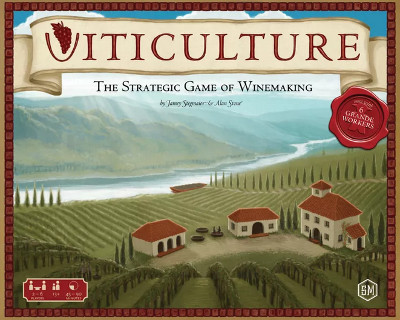
Viticulture is a strategic worker-placement board game set in Tuscany, accommodating 2-6 players with a 90-minute playtime.
Each player begins with a modest inheritance: a plot of land, a crushpad, a cellar, and three workers. The gameplay operates on a seasonal cycle, dividing actions between summer and winter phases. During summer, players can plant vines, build structures, give vineyard tours, and sell grapes. Winter activities include harvesting, crushing grapes, fulfilling wine orders, and training new workers.
Worker placement mechanics function on a first-come, first-served basis, with bonus actions available to the first player choosing specific spots. The game incorporates two types of visitor cards – summer and winter visitors – who provide special abilities, from extra actions to resource conversion. Players must manage their grape cultivation, paying attention to different varietals and their aging requirements. Wine tokens must be aged in cellars before they can fulfill specific order requirements.
Buildings enhance vineyard capabilities: the tasting room generates visitor interest, the windmill provides yearly bonuses, and the irrigation system aids grape cultivation. Victory points are earned primarily through completing wine orders, though additional points come from building structures, accumulating money, and hosting visitors. The first player to reach 20 victory points triggers the game’s final round.
Hallertau (2020)
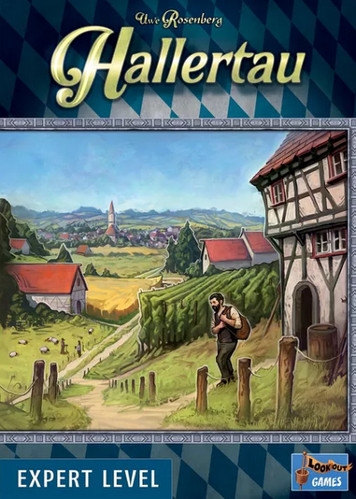
Hallertau takes players to Germany’s largest hop-producing region during the 1850s, where they manage a Bavarian village’s agricultural development.
This 1-4 player game, designed by Uwe Rosenberg, plays in 90-120 minutes. As village chiefs, players operate a complex worker placement system where each action space increases in cost (requires more workers) after being used. The core gameplay revolves around a unique two-field rotation mechanism – fields must rest between harvests, forcing players to carefully time their crop cycles.
The game features multiple interconnected systems:
- A community center with 12 different upgrades
- Sheep breeding with mortality timers
- Craft buildings that process raw materials
- A card-based crafting system with 180 unique cards
- Five different worker types with varying abilities
- Three separate resource tracks that affect scoring
Players must balance field management, sheep breeding (where animals expire after specific rounds), and the strategic use of cards from their hand. The progressive worker placement mechanic means early-round choices directly impact late-game options, as popular spaces become increasingly expensive to use. Victory is achieved through a combination of community center development, resource accumulation, and efficient use of the game’s various action spaces.
Lowlands (2018)
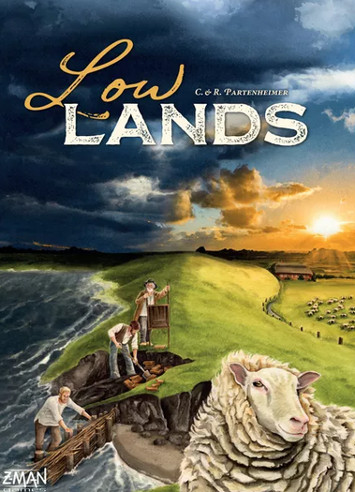
Lowlands is a 2-4 player farming and resource management game set in the North Sea coastal regions, playing in 50-100 minutes.
Players take on the role of farmers who must allocate their workers between two primary objectives: expanding their personal sheep farms and contributing to the communal dike construction. Each round, players:
- Place farmers on action spaces to gather resources
- Build farm improvements using building tiles
- Manage and grow their sheep population
- Choose whether to contribute to dike construction
The building system features unique tiles that provide both victory points and special abilities. Feeding troughs increase sheep capacity, while other structures offer various resource bonuses and scoring opportunities. The dike mechanism creates tension as flood waters rise each round – unprotected farms risk devastating losses.
Key Features:
- Variable setup ensures different strategies each game
- Dynamic flood control system that affects all players
- Modular building tiles with distinct benefits
- Interconnected scoring between personal development and community contribution
Victory points come from multiple sources: sheep count, farm buildings, dike contribution, and end-game bonuses. The player who best balances individual prosperity with community protection earns the highest score and wins.
